Managerial Accounting Report for Swipe 50 Limited: Profit Analysis
VerifiedAdded on 2021/10/06
|12
|4823
|208
Report
AI Summary
This report provides a detailed analysis of managerial accounting processes for Swipe 50 Limited, focusing on profit statements prepared using absorption and variable costing methods for February and March. The report includes profit reconciliation statements, comparing the results from both costing methods, and explains the differences and importance of each method. It also explores how fixed overhead expenses are treated. Further, the report examines three ways Swipe 50 Limited can improve its accounting systems and discusses the importance of a managing accountant within a manufacturing company. The report also includes calculations of cost of goods sold, gross margin, operating income, and contribution margin. The conclusion summarizes the key findings and provides recommendations for the company to enhance its financial reporting and decision-making processes.
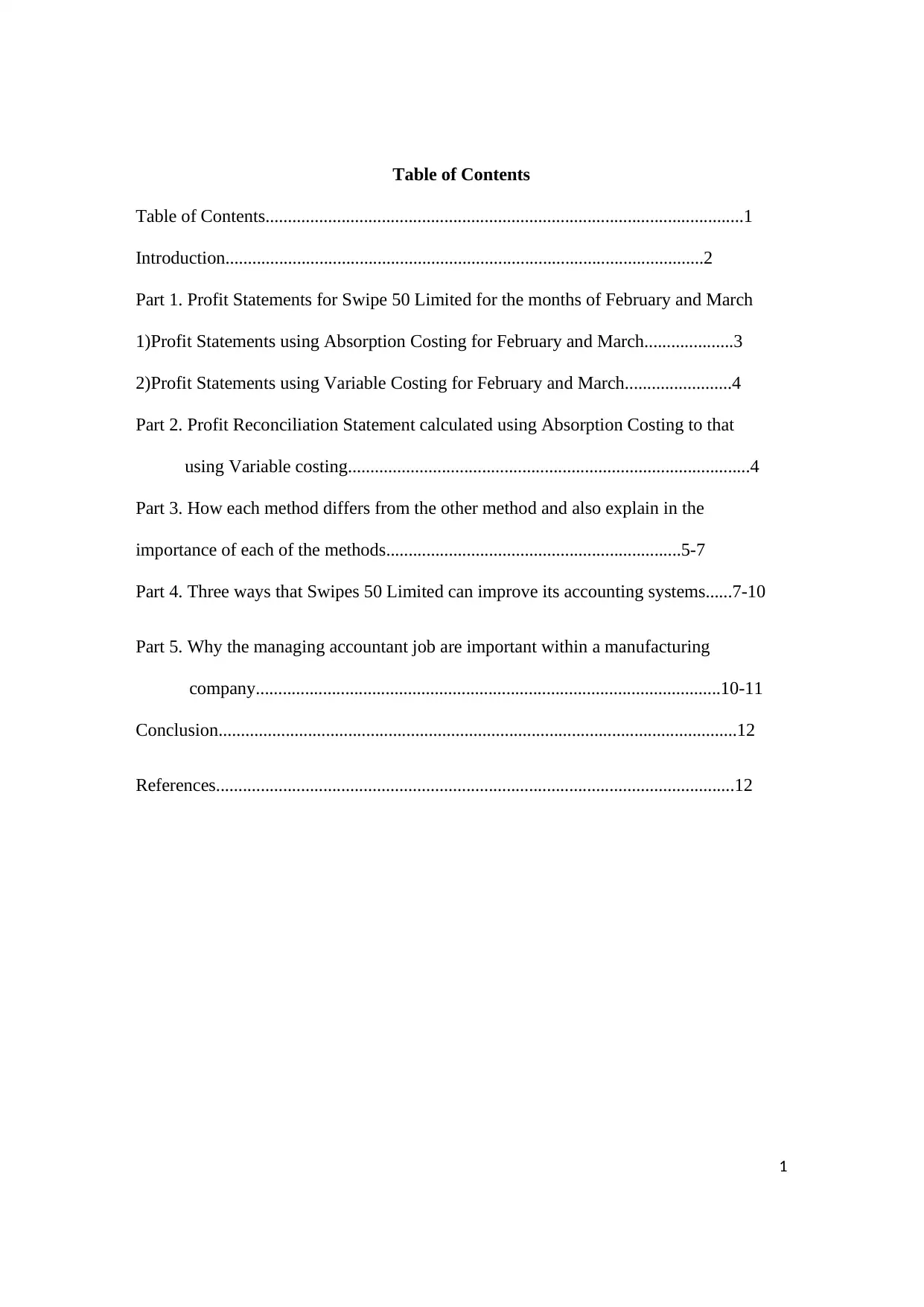
1
Table of Contents
Table of Contents...........................................................................................................1
Introduction...........................................................................................................2
Part 1. Profit Statements for Swipe 50 Limited for the months of February and March
1)Profit Statements using Absorption Costing for February and March....................3
2)Profit Statements using Variable Costing for February and March........................4
Part 2. Profit Reconciliation Statement calculated using Absorption Costing to that
using Variable costing..........................................................................................4
Part 3. How each method differs from the other method and also explain in the
importance of each of the methods..................................................................5-7
Part 4. Three ways that Swipes 50 Limited can improve its accounting systems......7-10
Part 5. Why the managing accountant job are important within a manufacturing
company........................................................................................................10-11
Conclusion....................................................................................................................12
References....................................................................................................................12
Table of Contents
Table of Contents...........................................................................................................1
Introduction...........................................................................................................2
Part 1. Profit Statements for Swipe 50 Limited for the months of February and March
1)Profit Statements using Absorption Costing for February and March....................3
2)Profit Statements using Variable Costing for February and March........................4
Part 2. Profit Reconciliation Statement calculated using Absorption Costing to that
using Variable costing..........................................................................................4
Part 3. How each method differs from the other method and also explain in the
importance of each of the methods..................................................................5-7
Part 4. Three ways that Swipes 50 Limited can improve its accounting systems......7-10
Part 5. Why the managing accountant job are important within a manufacturing
company........................................................................................................10-11
Conclusion....................................................................................................................12
References....................................................................................................................12
Paraphrase This Document
Need a fresh take? Get an instant paraphrase of this document with our AI Paraphraser
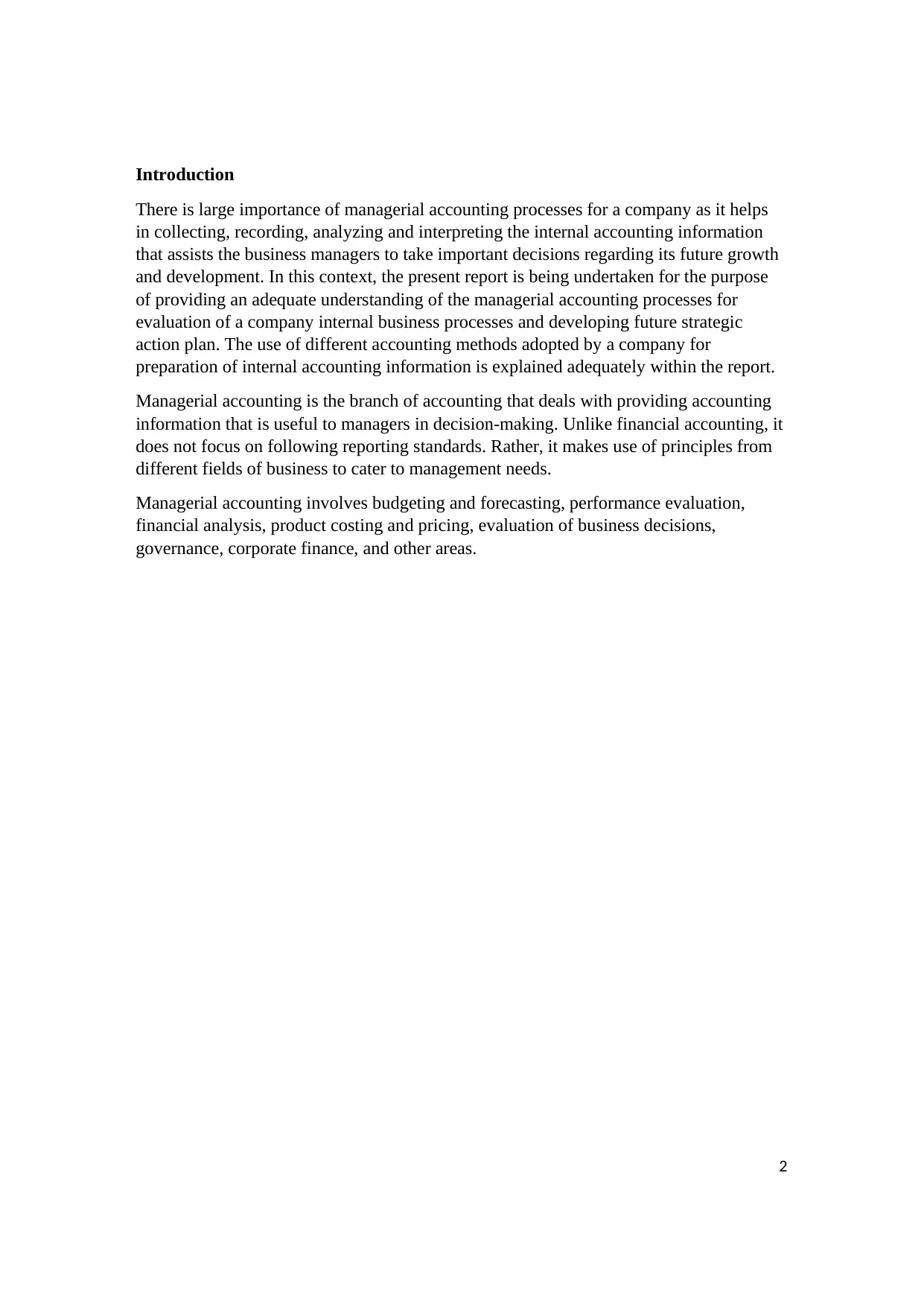
2
Introduction
There is large importance of managerial accounting processes for a company as it helps
in collecting, recording, analyzing and interpreting the internal accounting information
that assists the business managers to take important decisions regarding its future growth
and development. In this context, the present report is being undertaken for the purpose
of providing an adequate understanding of the managerial accounting processes for
evaluation of a company internal business processes and developing future strategic
action plan. The use of different accounting methods adopted by a company for
preparation of internal accounting information is explained adequately within the report.
Managerial accounting is the branch of accounting that deals with providing accounting
information that is useful to managers in decision-making. Unlike financial accounting, it
does not focus on following reporting standards. Rather, it makes use of principles from
different fields of business to cater to management needs.
Managerial accounting involves budgeting and forecasting, performance evaluation,
financial analysis, product costing and pricing, evaluation of business decisions,
governance, corporate finance, and other areas.
Introduction
There is large importance of managerial accounting processes for a company as it helps
in collecting, recording, analyzing and interpreting the internal accounting information
that assists the business managers to take important decisions regarding its future growth
and development. In this context, the present report is being undertaken for the purpose
of providing an adequate understanding of the managerial accounting processes for
evaluation of a company internal business processes and developing future strategic
action plan. The use of different accounting methods adopted by a company for
preparation of internal accounting information is explained adequately within the report.
Managerial accounting is the branch of accounting that deals with providing accounting
information that is useful to managers in decision-making. Unlike financial accounting, it
does not focus on following reporting standards. Rather, it makes use of principles from
different fields of business to cater to management needs.
Managerial accounting involves budgeting and forecasting, performance evaluation,
financial analysis, product costing and pricing, evaluation of business decisions,
governance, corporate finance, and other areas.
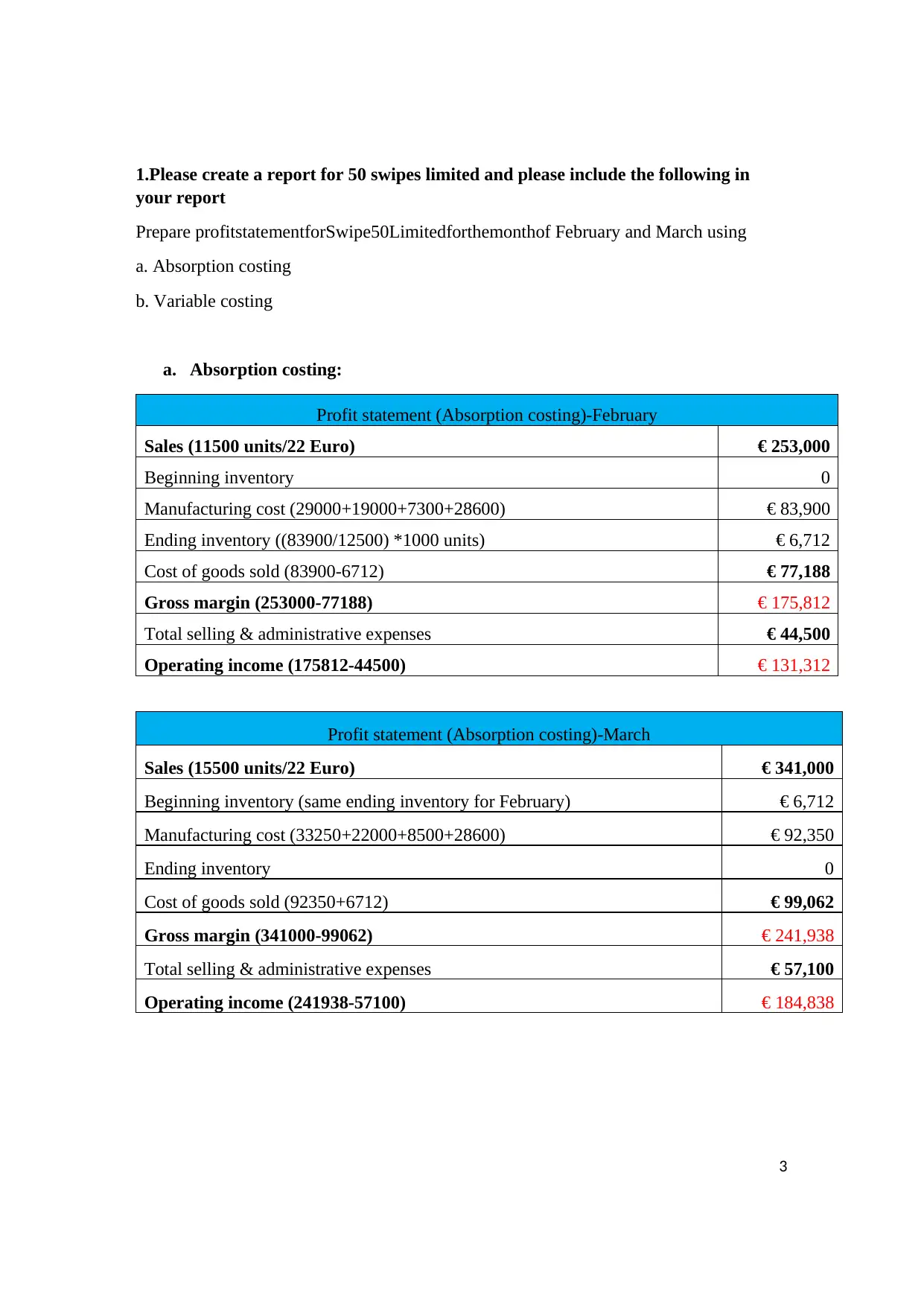
3
1.Please create a report for 50 swipes limited and please include the following in
your report
Prepare profitstatementforSwipe50Limitedforthemonthof February and March using
a. Absorption costing
b. Variable costing
a. Absorption costing:
Profit statement (Absorption costing)-February
Sales (11500 units/22 Euro) € 253,000
Beginning inventory 0
Manufacturing cost (29000+19000+7300+28600) € 83,900
Ending inventory ((83900/12500) *1000 units) € 6,712
Cost of goods sold (83900-6712) € 77,188
Gross margin (253000-77188) € 175,812
Total selling & administrative expenses € 44,500
Operating income (175812-44500) € 131,312
Profit statement (Absorption costing)-March
Sales (15500 units/22 Euro) € 341,000
Beginning inventory (same ending inventory for February) € 6,712
Manufacturing cost (33250+22000+8500+28600) € 92,350
Ending inventory 0
Cost of goods sold (92350+6712) € 99,062
Gross margin (341000-99062) € 241,938
Total selling & administrative expenses € 57,100
Operating income (241938-57100) € 184,838
1.Please create a report for 50 swipes limited and please include the following in
your report
Prepare profitstatementforSwipe50Limitedforthemonthof February and March using
a. Absorption costing
b. Variable costing
a. Absorption costing:
Profit statement (Absorption costing)-February
Sales (11500 units/22 Euro) € 253,000
Beginning inventory 0
Manufacturing cost (29000+19000+7300+28600) € 83,900
Ending inventory ((83900/12500) *1000 units) € 6,712
Cost of goods sold (83900-6712) € 77,188
Gross margin (253000-77188) € 175,812
Total selling & administrative expenses € 44,500
Operating income (175812-44500) € 131,312
Profit statement (Absorption costing)-March
Sales (15500 units/22 Euro) € 341,000
Beginning inventory (same ending inventory for February) € 6,712
Manufacturing cost (33250+22000+8500+28600) € 92,350
Ending inventory 0
Cost of goods sold (92350+6712) € 99,062
Gross margin (341000-99062) € 241,938
Total selling & administrative expenses € 57,100
Operating income (241938-57100) € 184,838
⊘ This is a preview!⊘
Do you want full access?
Subscribe today to unlock all pages.

Trusted by 1+ million students worldwide
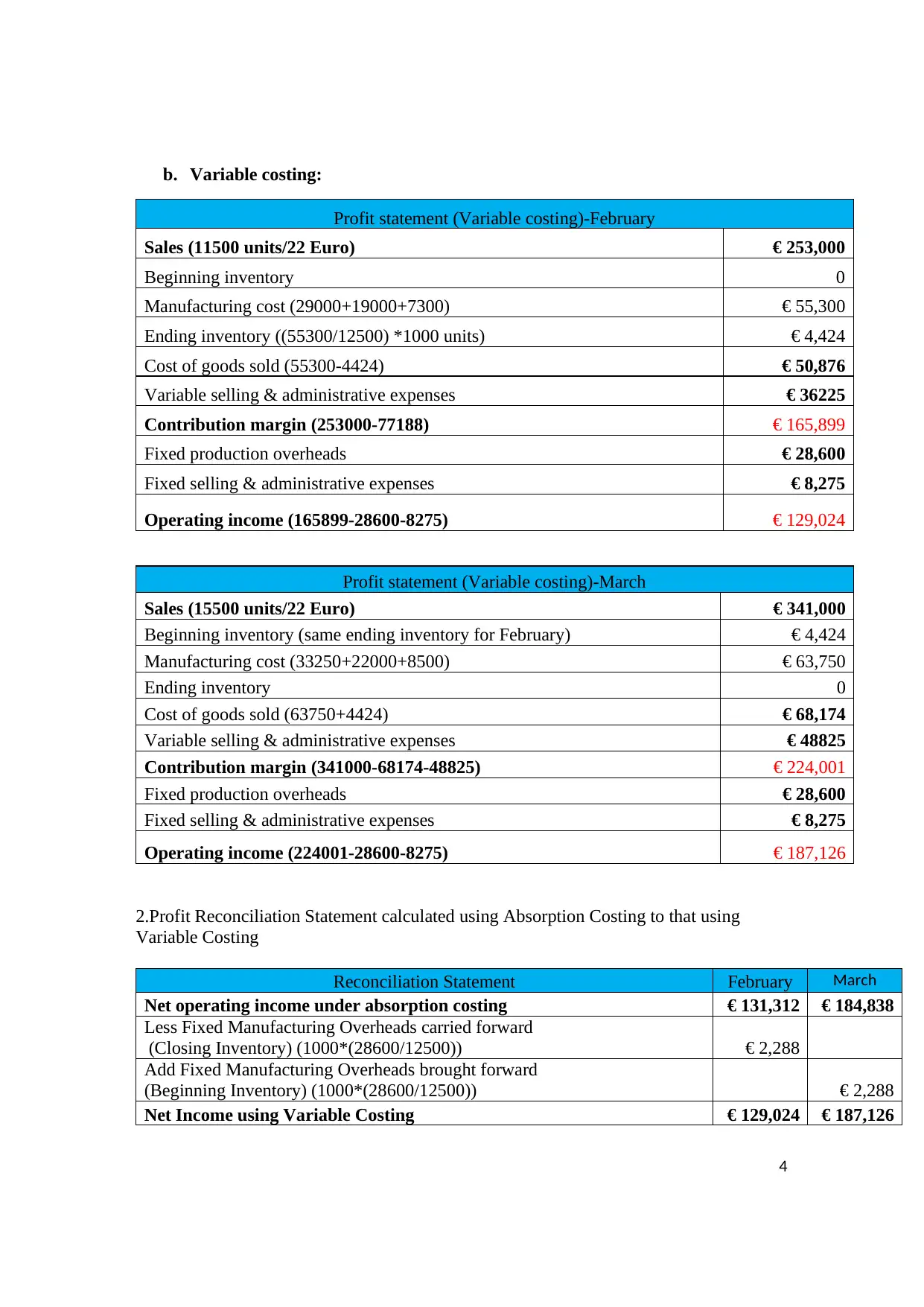
4
b. Variable costing:
Profit statement (Variable costing)-February
Sales (11500 units/22 Euro) € 253,000
Beginning inventory 0
Manufacturing cost (29000+19000+7300) € 55,300
Ending inventory ((55300/12500) *1000 units) € 4,424
Cost of goods sold (55300-4424) € 50,876
Variable selling & administrative expenses € 36225
Contribution margin (253000-77188) € 165,899
Fixed production overheads € 28,600
Fixed selling & administrative expenses € 8,275
Operating income (165899-28600-8275) € 129,024
Profit statement (Variable costing)-March
Sales (15500 units/22 Euro) € 341,000
Beginning inventory (same ending inventory for February) € 4,424
Manufacturing cost (33250+22000+8500) € 63,750
Ending inventory 0
Cost of goods sold (63750+4424) € 68,174
Variable selling & administrative expenses € 48825
Contribution margin (341000-68174-48825) € 224,001
Fixed production overheads € 28,600
Fixed selling & administrative expenses € 8,275
Operating income (224001-28600-8275) € 187,126
2.Profit Reconciliation Statement calculated using Absorption Costing to that using
Variable Costing
Reconciliation Statement February March
Net operating income under absorption costing € 131,312 € 184,838
Less Fixed Manufacturing Overheads carried forward
(Closing Inventory) (1000*(28600/12500)) € 2,288
Add Fixed Manufacturing Overheads brought forward
(Beginning Inventory) (1000*(28600/12500)) € 2,288
Net Income using Variable Costing € 129,024 € 187,126
b. Variable costing:
Profit statement (Variable costing)-February
Sales (11500 units/22 Euro) € 253,000
Beginning inventory 0
Manufacturing cost (29000+19000+7300) € 55,300
Ending inventory ((55300/12500) *1000 units) € 4,424
Cost of goods sold (55300-4424) € 50,876
Variable selling & administrative expenses € 36225
Contribution margin (253000-77188) € 165,899
Fixed production overheads € 28,600
Fixed selling & administrative expenses € 8,275
Operating income (165899-28600-8275) € 129,024
Profit statement (Variable costing)-March
Sales (15500 units/22 Euro) € 341,000
Beginning inventory (same ending inventory for February) € 4,424
Manufacturing cost (33250+22000+8500) € 63,750
Ending inventory 0
Cost of goods sold (63750+4424) € 68,174
Variable selling & administrative expenses € 48825
Contribution margin (341000-68174-48825) € 224,001
Fixed production overheads € 28,600
Fixed selling & administrative expenses € 8,275
Operating income (224001-28600-8275) € 187,126
2.Profit Reconciliation Statement calculated using Absorption Costing to that using
Variable Costing
Reconciliation Statement February March
Net operating income under absorption costing € 131,312 € 184,838
Less Fixed Manufacturing Overheads carried forward
(Closing Inventory) (1000*(28600/12500)) € 2,288
Add Fixed Manufacturing Overheads brought forward
(Beginning Inventory) (1000*(28600/12500)) € 2,288
Net Income using Variable Costing € 129,024 € 187,126
Paraphrase This Document
Need a fresh take? Get an instant paraphrase of this document with our AI Paraphraser
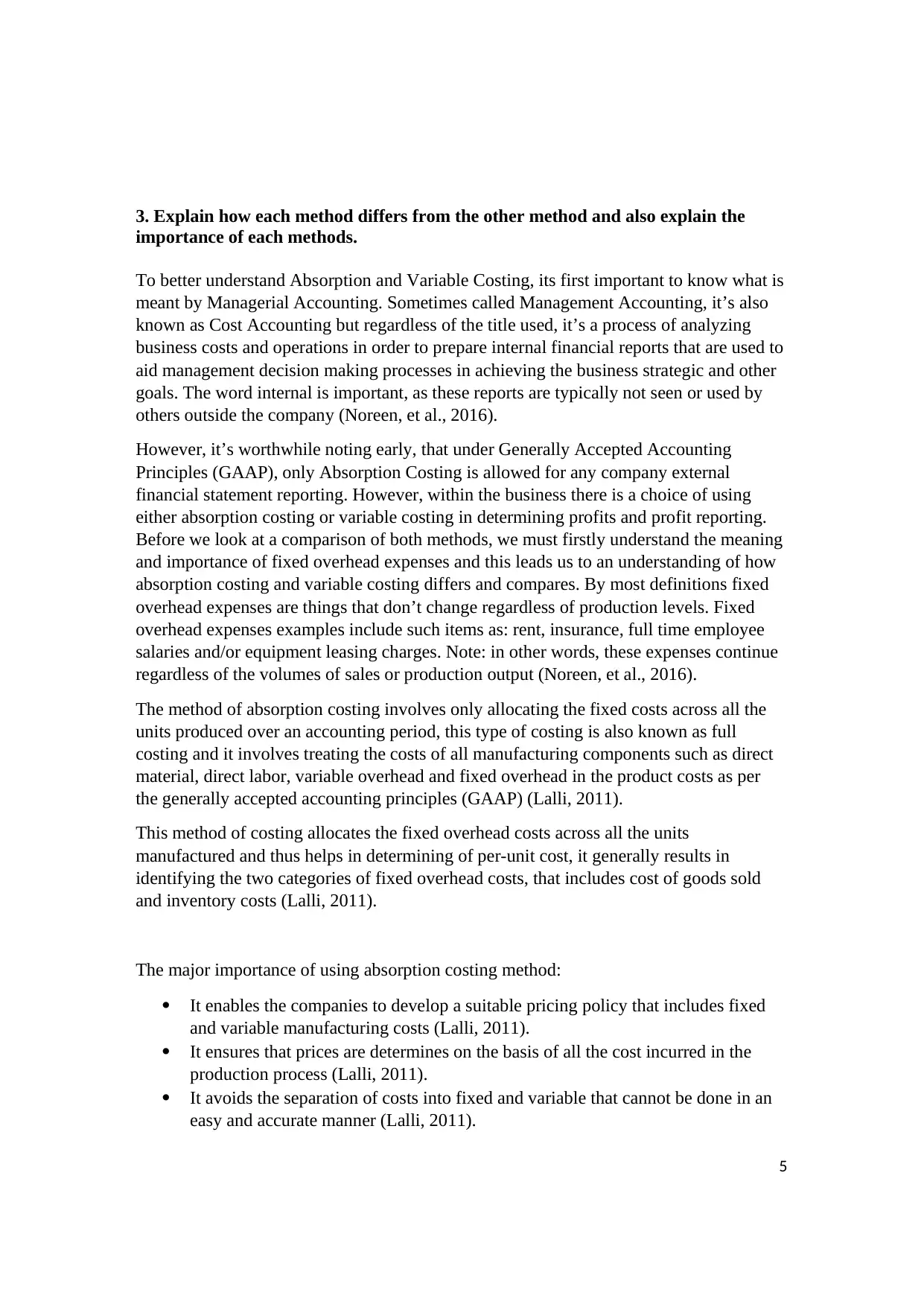
5
3. Explain how each method differs from the other method and also explain the
importance of each methods.
To better understand Absorption and Variable Costing, its first important to know what is
meant by Managerial Accounting. Sometimes called Management Accounting, it’s also
known as Cost Accounting but regardless of the title used, it’s a process of analyzing
business costs and operations in order to prepare internal financial reports that are used to
aid management decision making processes in achieving the business strategic and other
goals. The word internal is important, as these reports are typically not seen or used by
others outside the company (Noreen, et al., 2016).
However, it’s worthwhile noting early, that under Generally Accepted Accounting
Principles (GAAP), only Absorption Costing is allowed for any company external
financial statement reporting. However, within the business there is a choice of using
either absorption costing or variable costing in determining profits and profit reporting.
Before we look at a comparison of both methods, we must firstly understand the meaning
and importance of fixed overhead expenses and this leads us to an understanding of how
absorption costing and variable costing differs and compares. By most definitions fixed
overhead expenses are things that don’t change regardless of production levels. Fixed
overhead expenses examples include such items as: rent, insurance, full time employee
salaries and/or equipment leasing charges. Note: in other words, these expenses continue
regardless of the volumes of sales or production output (Noreen, et al., 2016).
The method of absorption costing involves only allocating the fixed costs across all the
units produced over an accounting period, this type of costing is also known as full
costing and it involves treating the costs of all manufacturing components such as direct
material, direct labor, variable overhead and fixed overhead in the product costs as per
the generally accepted accounting principles (GAAP) (Lalli, 2011).
This method of costing allocates the fixed overhead costs across all the units
manufactured and thus helps in determining of per-unit cost, it generally results in
identifying the two categories of fixed overhead costs, that includes cost of goods sold
and inventory costs (Lalli, 2011).
The major importance of using absorption costing method:
It enables the companies to develop a suitable pricing policy that includes fixed
and variable manufacturing costs (Lalli, 2011).
It ensures that prices are determines on the basis of all the cost incurred in the
production process (Lalli, 2011).
It avoids the separation of costs into fixed and variable that cannot be done in an
easy and accurate manner (Lalli, 2011).
3. Explain how each method differs from the other method and also explain the
importance of each methods.
To better understand Absorption and Variable Costing, its first important to know what is
meant by Managerial Accounting. Sometimes called Management Accounting, it’s also
known as Cost Accounting but regardless of the title used, it’s a process of analyzing
business costs and operations in order to prepare internal financial reports that are used to
aid management decision making processes in achieving the business strategic and other
goals. The word internal is important, as these reports are typically not seen or used by
others outside the company (Noreen, et al., 2016).
However, it’s worthwhile noting early, that under Generally Accepted Accounting
Principles (GAAP), only Absorption Costing is allowed for any company external
financial statement reporting. However, within the business there is a choice of using
either absorption costing or variable costing in determining profits and profit reporting.
Before we look at a comparison of both methods, we must firstly understand the meaning
and importance of fixed overhead expenses and this leads us to an understanding of how
absorption costing and variable costing differs and compares. By most definitions fixed
overhead expenses are things that don’t change regardless of production levels. Fixed
overhead expenses examples include such items as: rent, insurance, full time employee
salaries and/or equipment leasing charges. Note: in other words, these expenses continue
regardless of the volumes of sales or production output (Noreen, et al., 2016).
The method of absorption costing involves only allocating the fixed costs across all the
units produced over an accounting period, this type of costing is also known as full
costing and it involves treating the costs of all manufacturing components such as direct
material, direct labor, variable overhead and fixed overhead in the product costs as per
the generally accepted accounting principles (GAAP) (Lalli, 2011).
This method of costing allocates the fixed overhead costs across all the units
manufactured and thus helps in determining of per-unit cost, it generally results in
identifying the two categories of fixed overhead costs, that includes cost of goods sold
and inventory costs (Lalli, 2011).
The major importance of using absorption costing method:
It enables the companies to develop a suitable pricing policy that includes fixed
and variable manufacturing costs (Lalli, 2011).
It ensures that prices are determines on the basis of all the cost incurred in the
production process (Lalli, 2011).
It avoids the separation of costs into fixed and variable that cannot be done in an
easy and accurate manner (Lalli, 2011).
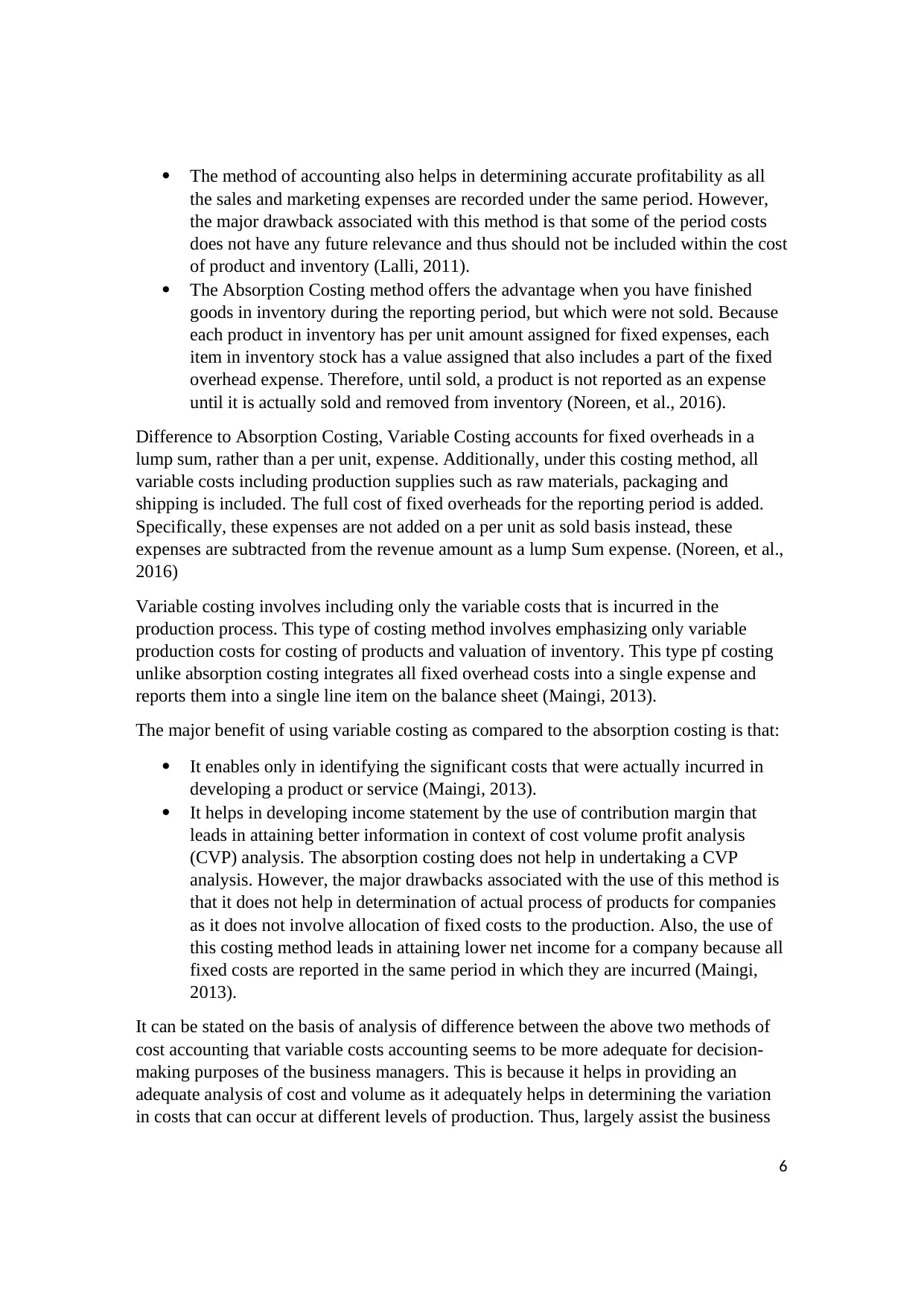
6
The method of accounting also helps in determining accurate profitability as all
the sales and marketing expenses are recorded under the same period. However,
the major drawback associated with this method is that some of the period costs
does not have any future relevance and thus should not be included within the cost
of product and inventory (Lalli, 2011).
The Absorption Costing method offers the advantage when you have finished
goods in inventory during the reporting period, but which were not sold. Because
each product in inventory has per unit amount assigned for fixed expenses, each
item in inventory stock has a value assigned that also includes a part of the fixed
overhead expense. Therefore, until sold, a product is not reported as an expense
until it is actually sold and removed from inventory (Noreen, et al., 2016).
Difference to Absorption Costing, Variable Costing accounts for fixed overheads in a
lump sum, rather than a per unit, expense. Additionally, under this costing method, all
variable costs including production supplies such as raw materials, packaging and
shipping is included. The full cost of fixed overheads for the reporting period is added.
Specifically, these expenses are not added on a per unit as sold basis instead, these
expenses are subtracted from the revenue amount as a lump Sum expense. (Noreen, et al.,
2016)
Variable costing involves including only the variable costs that is incurred in the
production process. This type of costing method involves emphasizing only variable
production costs for costing of products and valuation of inventory. This type pf costing
unlike absorption costing integrates all fixed overhead costs into a single expense and
reports them into a single line item on the balance sheet (Maingi, 2013).
The major benefit of using variable costing as compared to the absorption costing is that:
It enables only in identifying the significant costs that were actually incurred in
developing a product or service (Maingi, 2013).
It helps in developing income statement by the use of contribution margin that
leads in attaining better information in context of cost volume profit analysis
(CVP) analysis. The absorption costing does not help in undertaking a CVP
analysis. However, the major drawbacks associated with the use of this method is
that it does not help in determination of actual process of products for companies
as it does not involve allocation of fixed costs to the production. Also, the use of
this costing method leads in attaining lower net income for a company because all
fixed costs are reported in the same period in which they are incurred (Maingi,
2013).
It can be stated on the basis of analysis of difference between the above two methods of
cost accounting that variable costs accounting seems to be more adequate for decision-
making purposes of the business managers. This is because it helps in providing an
adequate analysis of cost and volume as it adequately helps in determining the variation
in costs that can occur at different levels of production. Thus, largely assist the business
The method of accounting also helps in determining accurate profitability as all
the sales and marketing expenses are recorded under the same period. However,
the major drawback associated with this method is that some of the period costs
does not have any future relevance and thus should not be included within the cost
of product and inventory (Lalli, 2011).
The Absorption Costing method offers the advantage when you have finished
goods in inventory during the reporting period, but which were not sold. Because
each product in inventory has per unit amount assigned for fixed expenses, each
item in inventory stock has a value assigned that also includes a part of the fixed
overhead expense. Therefore, until sold, a product is not reported as an expense
until it is actually sold and removed from inventory (Noreen, et al., 2016).
Difference to Absorption Costing, Variable Costing accounts for fixed overheads in a
lump sum, rather than a per unit, expense. Additionally, under this costing method, all
variable costs including production supplies such as raw materials, packaging and
shipping is included. The full cost of fixed overheads for the reporting period is added.
Specifically, these expenses are not added on a per unit as sold basis instead, these
expenses are subtracted from the revenue amount as a lump Sum expense. (Noreen, et al.,
2016)
Variable costing involves including only the variable costs that is incurred in the
production process. This type of costing method involves emphasizing only variable
production costs for costing of products and valuation of inventory. This type pf costing
unlike absorption costing integrates all fixed overhead costs into a single expense and
reports them into a single line item on the balance sheet (Maingi, 2013).
The major benefit of using variable costing as compared to the absorption costing is that:
It enables only in identifying the significant costs that were actually incurred in
developing a product or service (Maingi, 2013).
It helps in developing income statement by the use of contribution margin that
leads in attaining better information in context of cost volume profit analysis
(CVP) analysis. The absorption costing does not help in undertaking a CVP
analysis. However, the major drawbacks associated with the use of this method is
that it does not help in determination of actual process of products for companies
as it does not involve allocation of fixed costs to the production. Also, the use of
this costing method leads in attaining lower net income for a company because all
fixed costs are reported in the same period in which they are incurred (Maingi,
2013).
It can be stated on the basis of analysis of difference between the above two methods of
cost accounting that variable costs accounting seems to be more adequate for decision-
making purposes of the business managers. This is because it helps in providing an
adequate analysis of cost and volume as it adequately helps in determining the variation
in costs that can occur at different levels of production. Thus, largely assist the business
⊘ This is a preview!⊘
Do you want full access?
Subscribe today to unlock all pages.

Trusted by 1+ million students worldwide
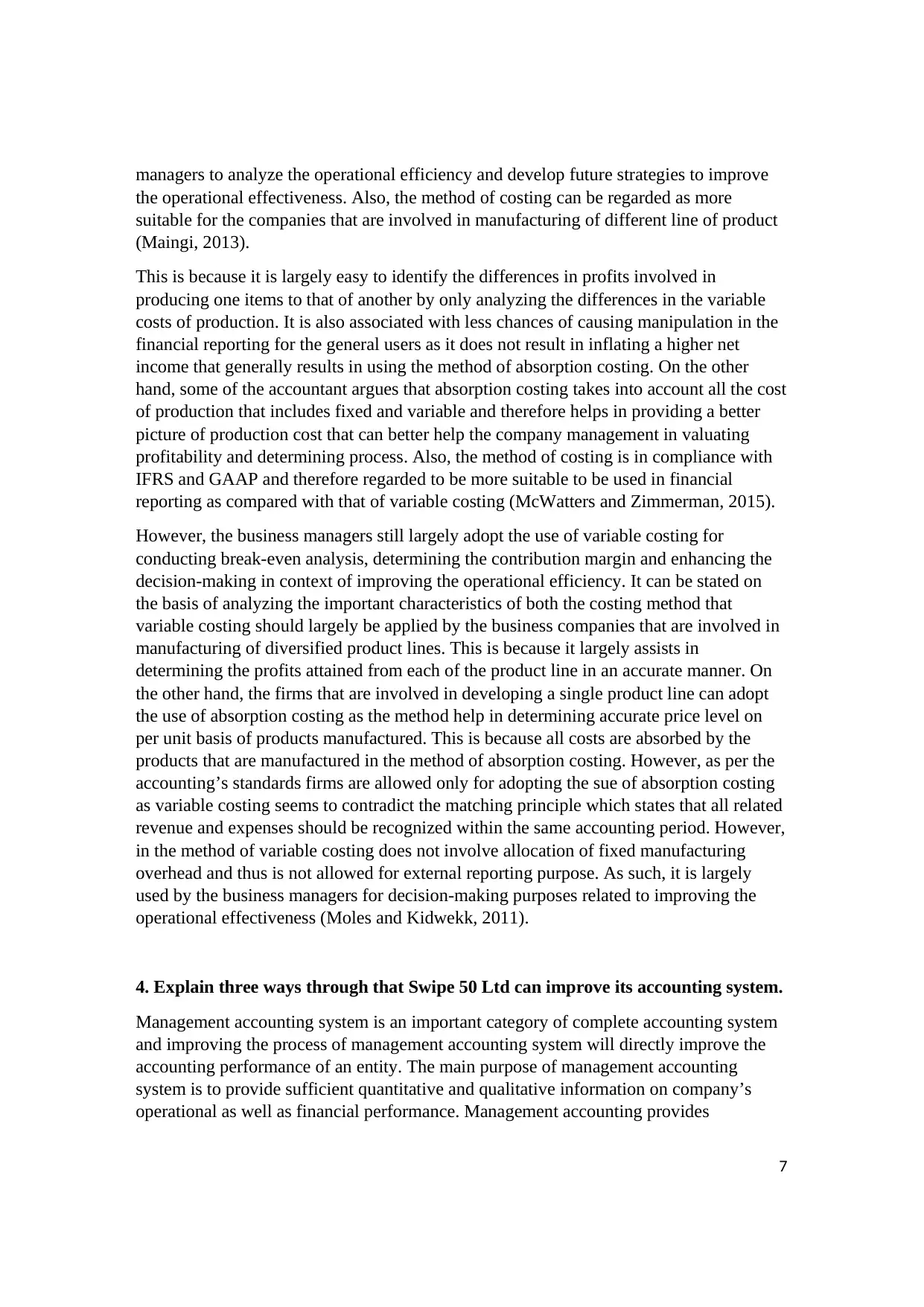
7
managers to analyze the operational efficiency and develop future strategies to improve
the operational effectiveness. Also, the method of costing can be regarded as more
suitable for the companies that are involved in manufacturing of different line of product
(Maingi, 2013).
This is because it is largely easy to identify the differences in profits involved in
producing one items to that of another by only analyzing the differences in the variable
costs of production. It is also associated with less chances of causing manipulation in the
financial reporting for the general users as it does not result in inflating a higher net
income that generally results in using the method of absorption costing. On the other
hand, some of the accountant argues that absorption costing takes into account all the cost
of production that includes fixed and variable and therefore helps in providing a better
picture of production cost that can better help the company management in valuating
profitability and determining process. Also, the method of costing is in compliance with
IFRS and GAAP and therefore regarded to be more suitable to be used in financial
reporting as compared with that of variable costing (McWatters and Zimmerman, 2015).
However, the business managers still largely adopt the use of variable costing for
conducting break-even analysis, determining the contribution margin and enhancing the
decision-making in context of improving the operational efficiency. It can be stated on
the basis of analyzing the important characteristics of both the costing method that
variable costing should largely be applied by the business companies that are involved in
manufacturing of diversified product lines. This is because it largely assists in
determining the profits attained from each of the product line in an accurate manner. On
the other hand, the firms that are involved in developing a single product line can adopt
the use of absorption costing as the method help in determining accurate price level on
per unit basis of products manufactured. This is because all costs are absorbed by the
products that are manufactured in the method of absorption costing. However, as per the
accounting’s standards firms are allowed only for adopting the sue of absorption costing
as variable costing seems to contradict the matching principle which states that all related
revenue and expenses should be recognized within the same accounting period. However,
in the method of variable costing does not involve allocation of fixed manufacturing
overhead and thus is not allowed for external reporting purpose. As such, it is largely
used by the business managers for decision-making purposes related to improving the
operational effectiveness (Moles and Kidwekk, 2011).
4. Explain three ways through that Swipe 50 Ltd can improve its accounting system.
Management accounting system is an important category of complete accounting system
and improving the process of management accounting system will directly improve the
accounting performance of an entity. The main purpose of management accounting
system is to provide sufficient quantitative and qualitative information on company’s
operational as well as financial performance. Management accounting provides
managers to analyze the operational efficiency and develop future strategies to improve
the operational effectiveness. Also, the method of costing can be regarded as more
suitable for the companies that are involved in manufacturing of different line of product
(Maingi, 2013).
This is because it is largely easy to identify the differences in profits involved in
producing one items to that of another by only analyzing the differences in the variable
costs of production. It is also associated with less chances of causing manipulation in the
financial reporting for the general users as it does not result in inflating a higher net
income that generally results in using the method of absorption costing. On the other
hand, some of the accountant argues that absorption costing takes into account all the cost
of production that includes fixed and variable and therefore helps in providing a better
picture of production cost that can better help the company management in valuating
profitability and determining process. Also, the method of costing is in compliance with
IFRS and GAAP and therefore regarded to be more suitable to be used in financial
reporting as compared with that of variable costing (McWatters and Zimmerman, 2015).
However, the business managers still largely adopt the use of variable costing for
conducting break-even analysis, determining the contribution margin and enhancing the
decision-making in context of improving the operational efficiency. It can be stated on
the basis of analyzing the important characteristics of both the costing method that
variable costing should largely be applied by the business companies that are involved in
manufacturing of diversified product lines. This is because it largely assists in
determining the profits attained from each of the product line in an accurate manner. On
the other hand, the firms that are involved in developing a single product line can adopt
the use of absorption costing as the method help in determining accurate price level on
per unit basis of products manufactured. This is because all costs are absorbed by the
products that are manufactured in the method of absorption costing. However, as per the
accounting’s standards firms are allowed only for adopting the sue of absorption costing
as variable costing seems to contradict the matching principle which states that all related
revenue and expenses should be recognized within the same accounting period. However,
in the method of variable costing does not involve allocation of fixed manufacturing
overhead and thus is not allowed for external reporting purpose. As such, it is largely
used by the business managers for decision-making purposes related to improving the
operational effectiveness (Moles and Kidwekk, 2011).
4. Explain three ways through that Swipe 50 Ltd can improve its accounting system.
Management accounting system is an important category of complete accounting system
and improving the process of management accounting system will directly improve the
accounting performance of an entity. The main purpose of management accounting
system is to provide sufficient quantitative and qualitative information on company’s
operational as well as financial performance. Management accounting provides
Paraphrase This Document
Need a fresh take? Get an instant paraphrase of this document with our AI Paraphraser
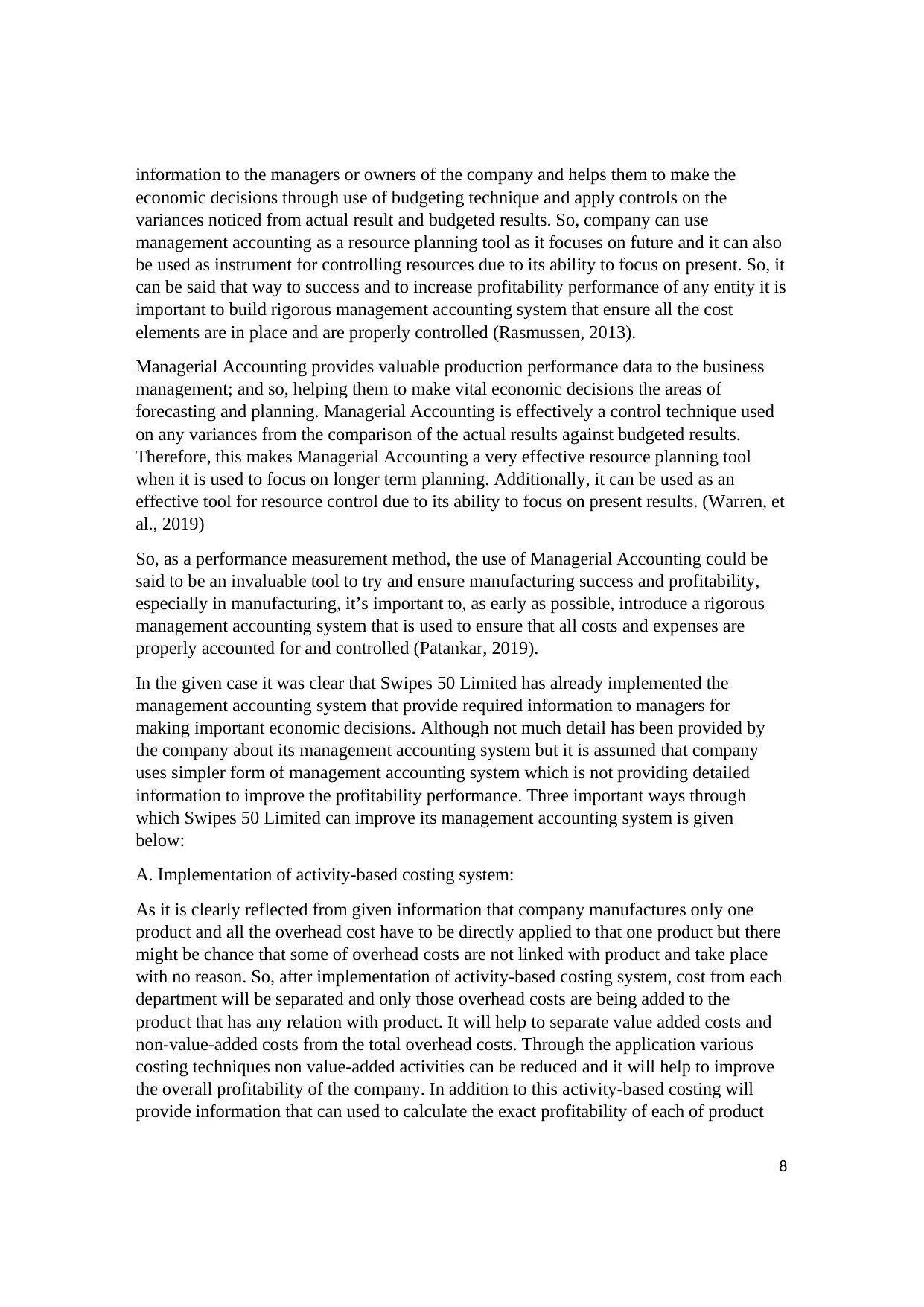
8
information to the managers or owners of the company and helps them to make the
economic decisions through use of budgeting technique and apply controls on the
variances noticed from actual result and budgeted results. So, company can use
management accounting as a resource planning tool as it focuses on future and it can also
be used as instrument for controlling resources due to its ability to focus on present. So, it
can be said that way to success and to increase profitability performance of any entity it is
important to build rigorous management accounting system that ensure all the cost
elements are in place and are properly controlled (Rasmussen, 2013).
Managerial Accounting provides valuable production performance data to the business
management; and so, helping them to make vital economic decisions the areas of
forecasting and planning. Managerial Accounting is effectively a control technique used
on any variances from the comparison of the actual results against budgeted results.
Therefore, this makes Managerial Accounting a very effective resource planning tool
when it is used to focus on longer term planning. Additionally, it can be used as an
effective tool for resource control due to its ability to focus on present results. (Warren, et
al., 2019)
So, as a performance measurement method, the use of Managerial Accounting could be
said to be an invaluable tool to try and ensure manufacturing success and profitability,
especially in manufacturing, it’s important to, as early as possible, introduce a rigorous
management accounting system that is used to ensure that all costs and expenses are
properly accounted for and controlled (Patankar, 2019).
In the given case it was clear that Swipes 50 Limited has already implemented the
management accounting system that provide required information to managers for
making important economic decisions. Although not much detail has been provided by
the company about its management accounting system but it is assumed that company
uses simpler form of management accounting system which is not providing detailed
information to improve the profitability performance. Three important ways through
which Swipes 50 Limited can improve its management accounting system is given
below:
A. Implementation of activity-based costing system:
As it is clearly reflected from given information that company manufactures only one
product and all the overhead cost have to be directly applied to that one product but there
might be chance that some of overhead costs are not linked with product and take place
with no reason. So, after implementation of activity-based costing system, cost from each
department will be separated and only those overhead costs are being added to the
product that has any relation with product. It will help to separate value added costs and
non-value-added costs from the total overhead costs. Through the application various
costing techniques non value-added activities can be reduced and it will help to improve
the overall profitability of the company. In addition to this activity-based costing will
provide information that can used to calculate the exact profitability of each of product
information to the managers or owners of the company and helps them to make the
economic decisions through use of budgeting technique and apply controls on the
variances noticed from actual result and budgeted results. So, company can use
management accounting as a resource planning tool as it focuses on future and it can also
be used as instrument for controlling resources due to its ability to focus on present. So, it
can be said that way to success and to increase profitability performance of any entity it is
important to build rigorous management accounting system that ensure all the cost
elements are in place and are properly controlled (Rasmussen, 2013).
Managerial Accounting provides valuable production performance data to the business
management; and so, helping them to make vital economic decisions the areas of
forecasting and planning. Managerial Accounting is effectively a control technique used
on any variances from the comparison of the actual results against budgeted results.
Therefore, this makes Managerial Accounting a very effective resource planning tool
when it is used to focus on longer term planning. Additionally, it can be used as an
effective tool for resource control due to its ability to focus on present results. (Warren, et
al., 2019)
So, as a performance measurement method, the use of Managerial Accounting could be
said to be an invaluable tool to try and ensure manufacturing success and profitability,
especially in manufacturing, it’s important to, as early as possible, introduce a rigorous
management accounting system that is used to ensure that all costs and expenses are
properly accounted for and controlled (Patankar, 2019).
In the given case it was clear that Swipes 50 Limited has already implemented the
management accounting system that provide required information to managers for
making important economic decisions. Although not much detail has been provided by
the company about its management accounting system but it is assumed that company
uses simpler form of management accounting system which is not providing detailed
information to improve the profitability performance. Three important ways through
which Swipes 50 Limited can improve its management accounting system is given
below:
A. Implementation of activity-based costing system:
As it is clearly reflected from given information that company manufactures only one
product and all the overhead cost have to be directly applied to that one product but there
might be chance that some of overhead costs are not linked with product and take place
with no reason. So, after implementation of activity-based costing system, cost from each
department will be separated and only those overhead costs are being added to the
product that has any relation with product. It will help to separate value added costs and
non-value-added costs from the total overhead costs. Through the application various
costing techniques non value-added activities can be reduced and it will help to improve
the overall profitability of the company. In addition to this activity-based costing will
provide information that can used to calculate the exact profitability of each of product
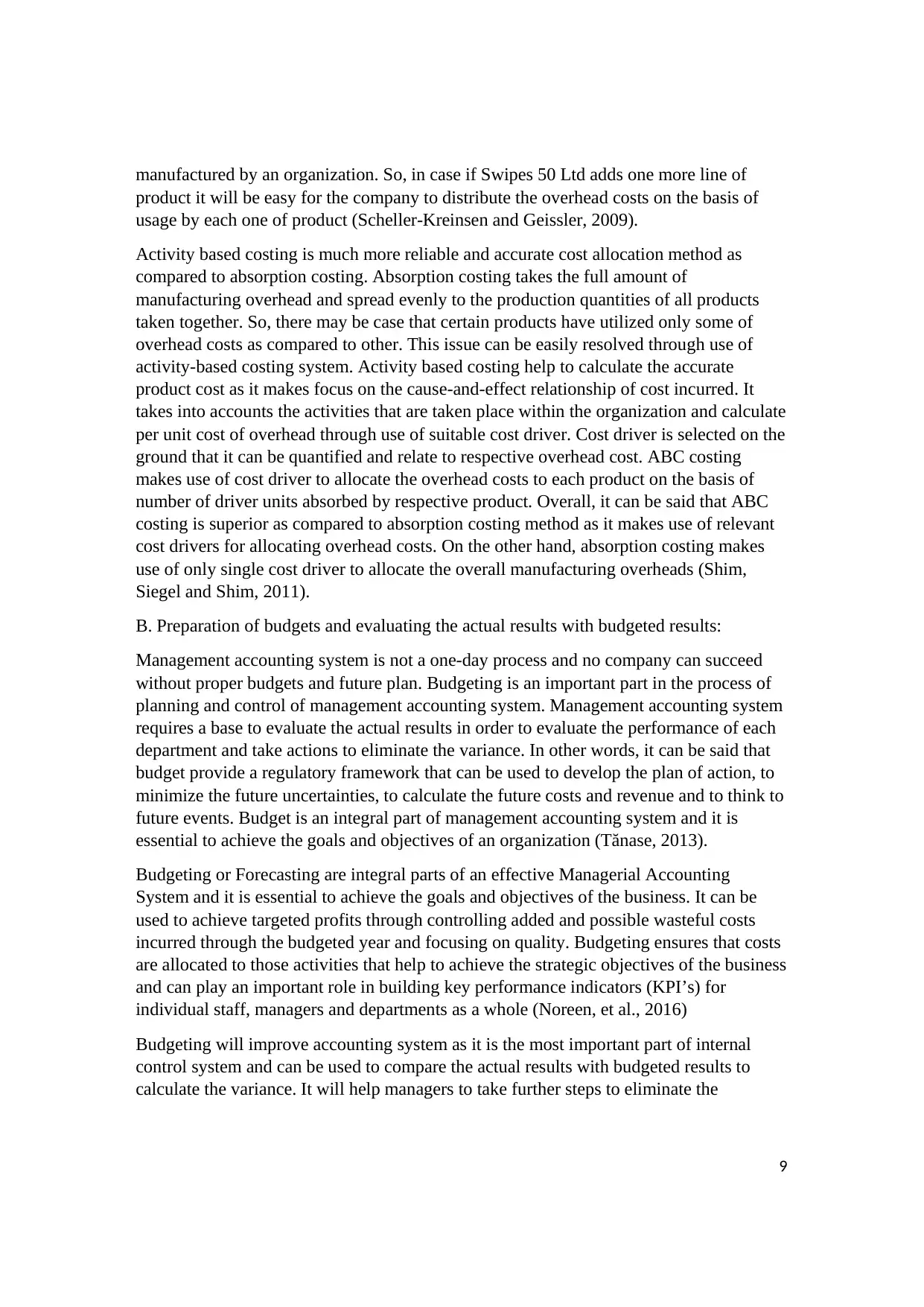
9
manufactured by an organization. So, in case if Swipes 50 Ltd adds one more line of
product it will be easy for the company to distribute the overhead costs on the basis of
usage by each one of product (Scheller-Kreinsen and Geissler, 2009).
Activity based costing is much more reliable and accurate cost allocation method as
compared to absorption costing. Absorption costing takes the full amount of
manufacturing overhead and spread evenly to the production quantities of all products
taken together. So, there may be case that certain products have utilized only some of
overhead costs as compared to other. This issue can be easily resolved through use of
activity-based costing system. Activity based costing help to calculate the accurate
product cost as it makes focus on the cause-and-effect relationship of cost incurred. It
takes into accounts the activities that are taken place within the organization and calculate
per unit cost of overhead through use of suitable cost driver. Cost driver is selected on the
ground that it can be quantified and relate to respective overhead cost. ABC costing
makes use of cost driver to allocate the overhead costs to each product on the basis of
number of driver units absorbed by respective product. Overall, it can be said that ABC
costing is superior as compared to absorption costing method as it makes use of relevant
cost drivers for allocating overhead costs. On the other hand, absorption costing makes
use of only single cost driver to allocate the overall manufacturing overheads (Shim,
Siegel and Shim, 2011).
B. Preparation of budgets and evaluating the actual results with budgeted results:
Management accounting system is not a one-day process and no company can succeed
without proper budgets and future plan. Budgeting is an important part in the process of
planning and control of management accounting system. Management accounting system
requires a base to evaluate the actual results in order to evaluate the performance of each
department and take actions to eliminate the variance. In other words, it can be said that
budget provide a regulatory framework that can be used to develop the plan of action, to
minimize the future uncertainties, to calculate the future costs and revenue and to think to
future events. Budget is an integral part of management accounting system and it is
essential to achieve the goals and objectives of an organization (Tănase, 2013).
Budgeting or Forecasting are integral parts of an effective Managerial Accounting
System and it is essential to achieve the goals and objectives of the business. It can be
used to achieve targeted profits through controlling added and possible wasteful costs
incurred through the budgeted year and focusing on quality. Budgeting ensures that costs
are allocated to those activities that help to achieve the strategic objectives of the business
and can play an important role in building key performance indicators (KPI’s) for
individual staff, managers and departments as a whole (Noreen, et al., 2016)
Budgeting will improve accounting system as it is the most important part of internal
control system and can be used to compare the actual results with budgeted results to
calculate the variance. It will help managers to take further steps to eliminate the
manufactured by an organization. So, in case if Swipes 50 Ltd adds one more line of
product it will be easy for the company to distribute the overhead costs on the basis of
usage by each one of product (Scheller-Kreinsen and Geissler, 2009).
Activity based costing is much more reliable and accurate cost allocation method as
compared to absorption costing. Absorption costing takes the full amount of
manufacturing overhead and spread evenly to the production quantities of all products
taken together. So, there may be case that certain products have utilized only some of
overhead costs as compared to other. This issue can be easily resolved through use of
activity-based costing system. Activity based costing help to calculate the accurate
product cost as it makes focus on the cause-and-effect relationship of cost incurred. It
takes into accounts the activities that are taken place within the organization and calculate
per unit cost of overhead through use of suitable cost driver. Cost driver is selected on the
ground that it can be quantified and relate to respective overhead cost. ABC costing
makes use of cost driver to allocate the overhead costs to each product on the basis of
number of driver units absorbed by respective product. Overall, it can be said that ABC
costing is superior as compared to absorption costing method as it makes use of relevant
cost drivers for allocating overhead costs. On the other hand, absorption costing makes
use of only single cost driver to allocate the overall manufacturing overheads (Shim,
Siegel and Shim, 2011).
B. Preparation of budgets and evaluating the actual results with budgeted results:
Management accounting system is not a one-day process and no company can succeed
without proper budgets and future plan. Budgeting is an important part in the process of
planning and control of management accounting system. Management accounting system
requires a base to evaluate the actual results in order to evaluate the performance of each
department and take actions to eliminate the variance. In other words, it can be said that
budget provide a regulatory framework that can be used to develop the plan of action, to
minimize the future uncertainties, to calculate the future costs and revenue and to think to
future events. Budget is an integral part of management accounting system and it is
essential to achieve the goals and objectives of an organization (Tănase, 2013).
Budgeting or Forecasting are integral parts of an effective Managerial Accounting
System and it is essential to achieve the goals and objectives of the business. It can be
used to achieve targeted profits through controlling added and possible wasteful costs
incurred through the budgeted year and focusing on quality. Budgeting ensures that costs
are allocated to those activities that help to achieve the strategic objectives of the business
and can play an important role in building key performance indicators (KPI’s) for
individual staff, managers and departments as a whole (Noreen, et al., 2016)
Budgeting will improve accounting system as it is the most important part of internal
control system and can be used to compare the actual results with budgeted results to
calculate the variance. It will help managers to take further steps to eliminate the
⊘ This is a preview!⊘
Do you want full access?
Subscribe today to unlock all pages.

Trusted by 1+ million students worldwide
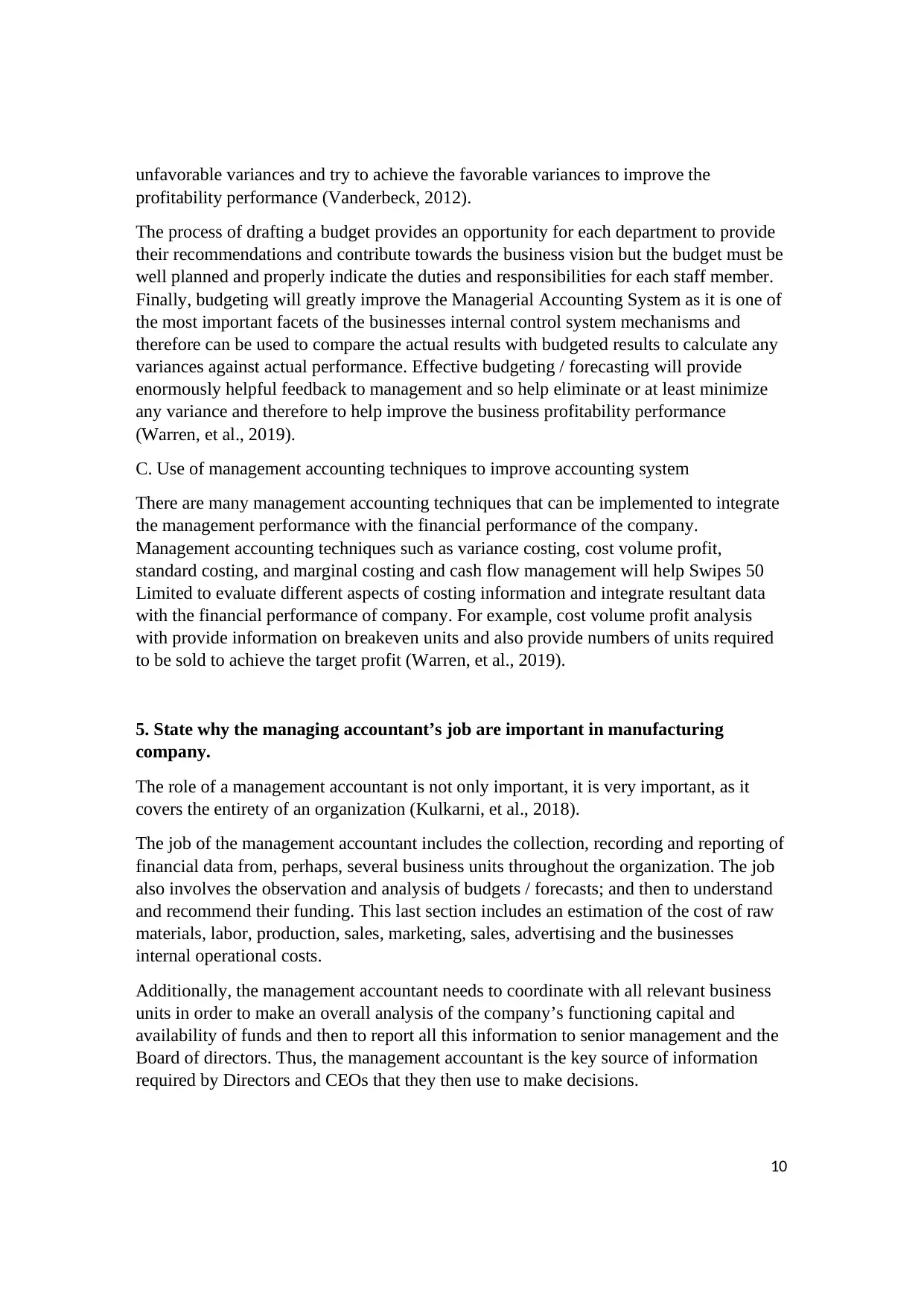
10
unfavorable variances and try to achieve the favorable variances to improve the
profitability performance (Vanderbeck, 2012).
The process of drafting a budget provides an opportunity for each department to provide
their recommendations and contribute towards the business vision but the budget must be
well planned and properly indicate the duties and responsibilities for each staff member.
Finally, budgeting will greatly improve the Managerial Accounting System as it is one of
the most important facets of the businesses internal control system mechanisms and
therefore can be used to compare the actual results with budgeted results to calculate any
variances against actual performance. Effective budgeting / forecasting will provide
enormously helpful feedback to management and so help eliminate or at least minimize
any variance and therefore to help improve the business profitability performance
(Warren, et al., 2019).
C. Use of management accounting techniques to improve accounting system
There are many management accounting techniques that can be implemented to integrate
the management performance with the financial performance of the company.
Management accounting techniques such as variance costing, cost volume profit,
standard costing, and marginal costing and cash flow management will help Swipes 50
Limited to evaluate different aspects of costing information and integrate resultant data
with the financial performance of company. For example, cost volume profit analysis
with provide information on breakeven units and also provide numbers of units required
to be sold to achieve the target profit (Warren, et al., 2019).
5. State why the managing accountant’s job are important in manufacturing
company.
The role of a management accountant is not only important, it is very important, as it
covers the entirety of an organization (Kulkarni, et al., 2018).
The job of the management accountant includes the collection, recording and reporting of
financial data from, perhaps, several business units throughout the organization. The job
also involves the observation and analysis of budgets / forecasts; and then to understand
and recommend their funding. This last section includes an estimation of the cost of raw
materials, labor, production, sales, marketing, sales, advertising and the businesses
internal operational costs.
Additionally, the management accountant needs to coordinate with all relevant business
units in order to make an overall analysis of the company’s functioning capital and
availability of funds and then to report all this information to senior management and the
Board of directors. Thus, the management accountant is the key source of information
required by Directors and CEOs that they then use to make decisions.
unfavorable variances and try to achieve the favorable variances to improve the
profitability performance (Vanderbeck, 2012).
The process of drafting a budget provides an opportunity for each department to provide
their recommendations and contribute towards the business vision but the budget must be
well planned and properly indicate the duties and responsibilities for each staff member.
Finally, budgeting will greatly improve the Managerial Accounting System as it is one of
the most important facets of the businesses internal control system mechanisms and
therefore can be used to compare the actual results with budgeted results to calculate any
variances against actual performance. Effective budgeting / forecasting will provide
enormously helpful feedback to management and so help eliminate or at least minimize
any variance and therefore to help improve the business profitability performance
(Warren, et al., 2019).
C. Use of management accounting techniques to improve accounting system
There are many management accounting techniques that can be implemented to integrate
the management performance with the financial performance of the company.
Management accounting techniques such as variance costing, cost volume profit,
standard costing, and marginal costing and cash flow management will help Swipes 50
Limited to evaluate different aspects of costing information and integrate resultant data
with the financial performance of company. For example, cost volume profit analysis
with provide information on breakeven units and also provide numbers of units required
to be sold to achieve the target profit (Warren, et al., 2019).
5. State why the managing accountant’s job are important in manufacturing
company.
The role of a management accountant is not only important, it is very important, as it
covers the entirety of an organization (Kulkarni, et al., 2018).
The job of the management accountant includes the collection, recording and reporting of
financial data from, perhaps, several business units throughout the organization. The job
also involves the observation and analysis of budgets / forecasts; and then to understand
and recommend their funding. This last section includes an estimation of the cost of raw
materials, labor, production, sales, marketing, sales, advertising and the businesses
internal operational costs.
Additionally, the management accountant needs to coordinate with all relevant business
units in order to make an overall analysis of the company’s functioning capital and
availability of funds and then to report all this information to senior management and the
Board of directors. Thus, the management accountant is the key source of information
required by Directors and CEOs that they then use to make decisions.
Paraphrase This Document
Need a fresh take? Get an instant paraphrase of this document with our AI Paraphraser
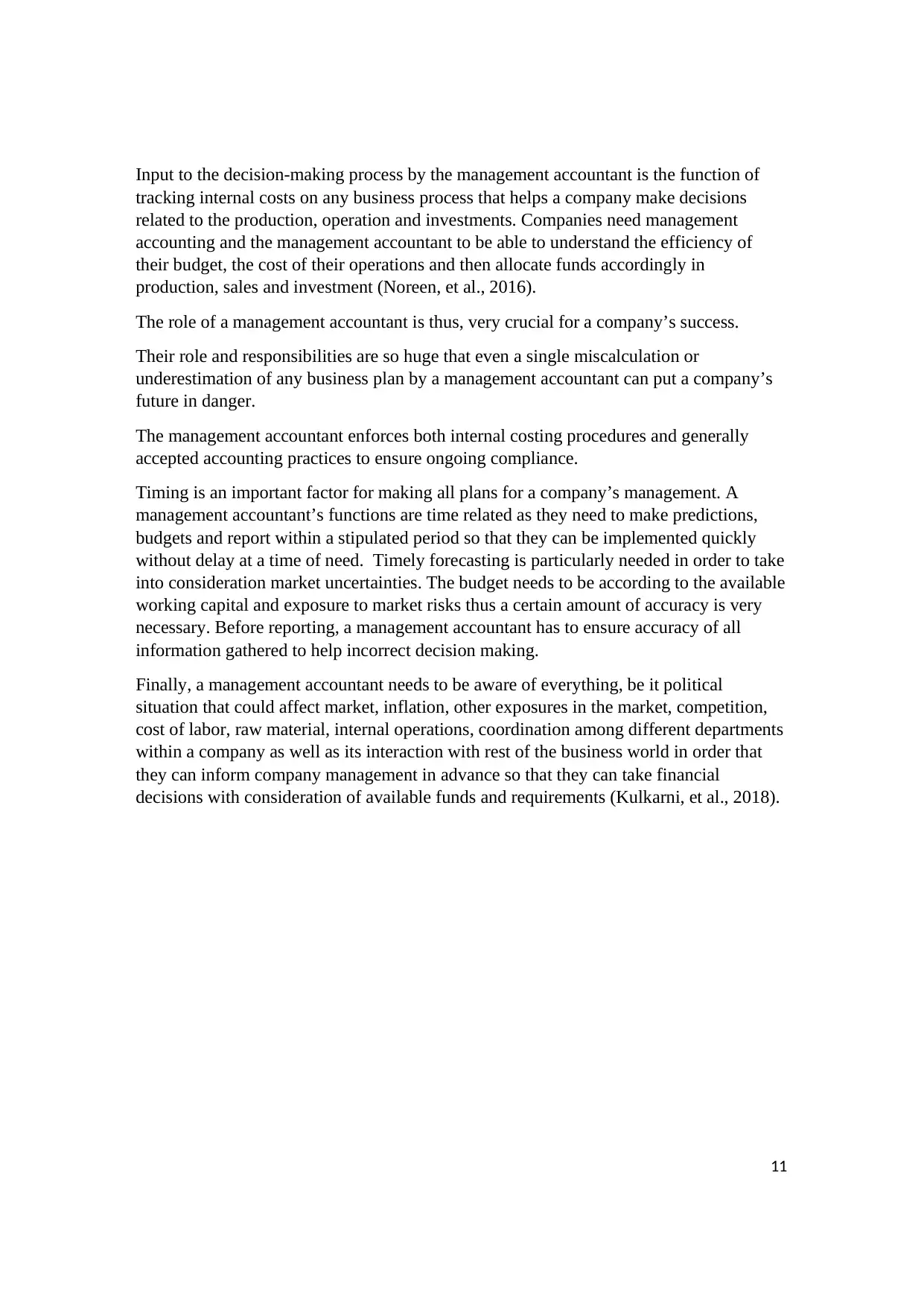
11
Input to the decision-making process by the management accountant is the function of
tracking internal costs on any business process that helps a company make decisions
related to the production, operation and investments. Companies need management
accounting and the management accountant to be able to understand the efficiency of
their budget, the cost of their operations and then allocate funds accordingly in
production, sales and investment (Noreen, et al., 2016).
The role of a management accountant is thus, very crucial for a company’s success.
Their role and responsibilities are so huge that even a single miscalculation or
underestimation of any business plan by a management accountant can put a company’s
future in danger.
The management accountant enforces both internal costing procedures and generally
accepted accounting practices to ensure ongoing compliance.
Timing is an important factor for making all plans for a company’s management. A
management accountant’s functions are time related as they need to make predictions,
budgets and report within a stipulated period so that they can be implemented quickly
without delay at a time of need. Timely forecasting is particularly needed in order to take
into consideration market uncertainties. The budget needs to be according to the available
working capital and exposure to market risks thus a certain amount of accuracy is very
necessary. Before reporting, a management accountant has to ensure accuracy of all
information gathered to help incorrect decision making.
Finally, a management accountant needs to be aware of everything, be it political
situation that could affect market, inflation, other exposures in the market, competition,
cost of labor, raw material, internal operations, coordination among different departments
within a company as well as its interaction with rest of the business world in order that
they can inform company management in advance so that they can take financial
decisions with consideration of available funds and requirements (Kulkarni, et al., 2018).
Input to the decision-making process by the management accountant is the function of
tracking internal costs on any business process that helps a company make decisions
related to the production, operation and investments. Companies need management
accounting and the management accountant to be able to understand the efficiency of
their budget, the cost of their operations and then allocate funds accordingly in
production, sales and investment (Noreen, et al., 2016).
The role of a management accountant is thus, very crucial for a company’s success.
Their role and responsibilities are so huge that even a single miscalculation or
underestimation of any business plan by a management accountant can put a company’s
future in danger.
The management accountant enforces both internal costing procedures and generally
accepted accounting practices to ensure ongoing compliance.
Timing is an important factor for making all plans for a company’s management. A
management accountant’s functions are time related as they need to make predictions,
budgets and report within a stipulated period so that they can be implemented quickly
without delay at a time of need. Timely forecasting is particularly needed in order to take
into consideration market uncertainties. The budget needs to be according to the available
working capital and exposure to market risks thus a certain amount of accuracy is very
necessary. Before reporting, a management accountant has to ensure accuracy of all
information gathered to help incorrect decision making.
Finally, a management accountant needs to be aware of everything, be it political
situation that could affect market, inflation, other exposures in the market, competition,
cost of labor, raw material, internal operations, coordination among different departments
within a company as well as its interaction with rest of the business world in order that
they can inform company management in advance so that they can take financial
decisions with consideration of available funds and requirements (Kulkarni, et al., 2018).
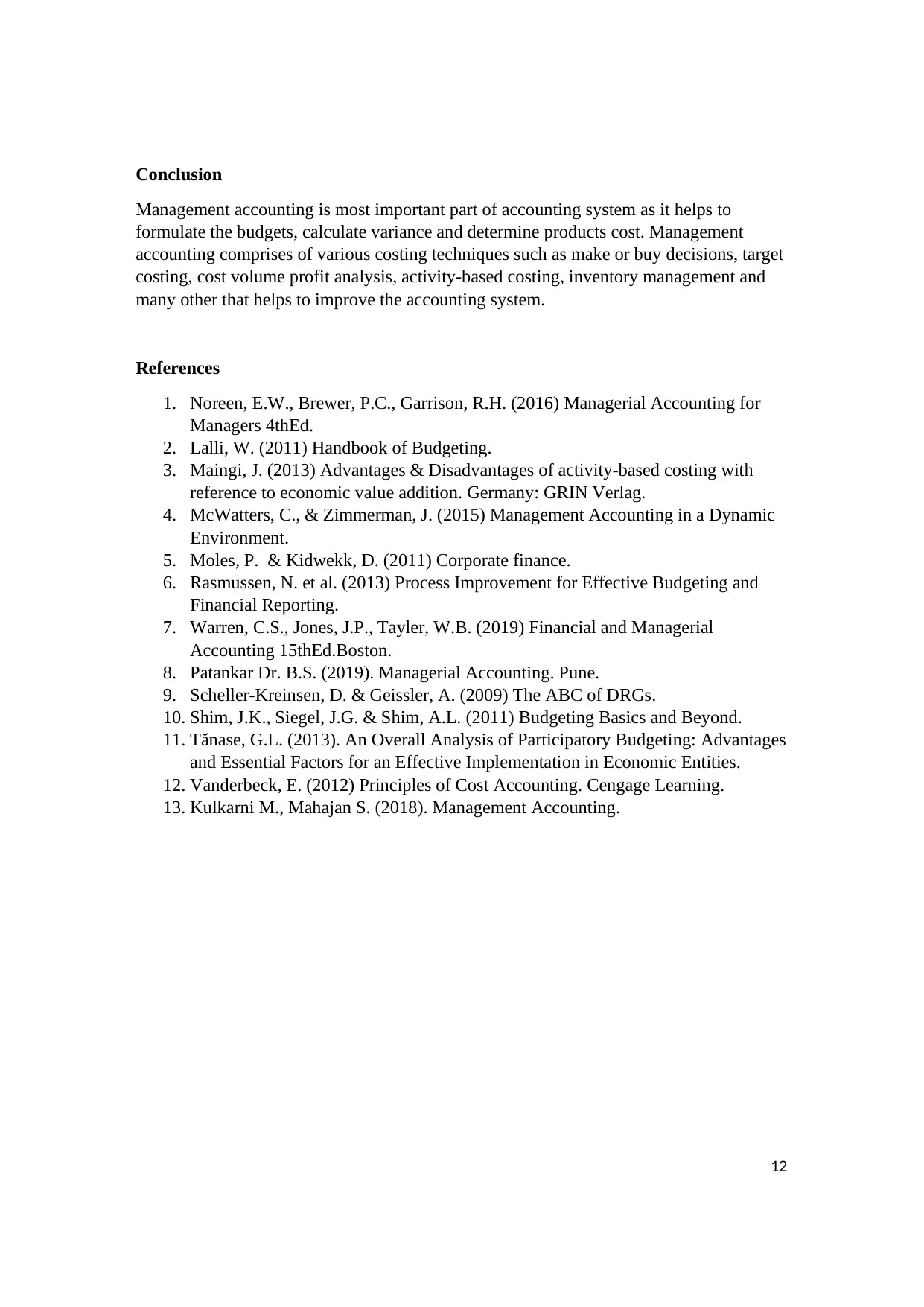
12
Conclusion
Management accounting is most important part of accounting system as it helps to
formulate the budgets, calculate variance and determine products cost. Management
accounting comprises of various costing techniques such as make or buy decisions, target
costing, cost volume profit analysis, activity-based costing, inventory management and
many other that helps to improve the accounting system.
References
1. Noreen, E.W., Brewer, P.C., Garrison, R.H. (2016) Managerial Accounting for
Managers 4thEd.
2. Lalli, W. (2011) Handbook of Budgeting.
3. Maingi, J. (2013) Advantages & Disadvantages of activity-based costing with
reference to economic value addition. Germany: GRIN Verlag.
4. McWatters, C., & Zimmerman, J. (2015) Management Accounting in a Dynamic
Environment.
5. Moles, P. & Kidwekk, D. (2011) Corporate finance.
6. Rasmussen, N. et al. (2013) Process Improvement for Effective Budgeting and
Financial Reporting.
7. Warren, C.S., Jones, J.P., Tayler, W.B. (2019) Financial and Managerial
Accounting 15thEd.Boston.
8. Patankar Dr. B.S. (2019). Managerial Accounting. Pune.
9. Scheller-Kreinsen, D. & Geissler, A. (2009) The ABC of DRGs.
10. Shim, J.K., Siegel, J.G. & Shim, A.L. (2011) Budgeting Basics and Beyond.
11. Tănase, G.L. (2013). An Overall Analysis of Participatory Budgeting: Advantages
and Essential Factors for an Effective Implementation in Economic Entities.
12. Vanderbeck, E. (2012) Principles of Cost Accounting. Cengage Learning.
13. Kulkarni M., Mahajan S. (2018). Management Accounting.
Conclusion
Management accounting is most important part of accounting system as it helps to
formulate the budgets, calculate variance and determine products cost. Management
accounting comprises of various costing techniques such as make or buy decisions, target
costing, cost volume profit analysis, activity-based costing, inventory management and
many other that helps to improve the accounting system.
References
1. Noreen, E.W., Brewer, P.C., Garrison, R.H. (2016) Managerial Accounting for
Managers 4thEd.
2. Lalli, W. (2011) Handbook of Budgeting.
3. Maingi, J. (2013) Advantages & Disadvantages of activity-based costing with
reference to economic value addition. Germany: GRIN Verlag.
4. McWatters, C., & Zimmerman, J. (2015) Management Accounting in a Dynamic
Environment.
5. Moles, P. & Kidwekk, D. (2011) Corporate finance.
6. Rasmussen, N. et al. (2013) Process Improvement for Effective Budgeting and
Financial Reporting.
7. Warren, C.S., Jones, J.P., Tayler, W.B. (2019) Financial and Managerial
Accounting 15thEd.Boston.
8. Patankar Dr. B.S. (2019). Managerial Accounting. Pune.
9. Scheller-Kreinsen, D. & Geissler, A. (2009) The ABC of DRGs.
10. Shim, J.K., Siegel, J.G. & Shim, A.L. (2011) Budgeting Basics and Beyond.
11. Tănase, G.L. (2013). An Overall Analysis of Participatory Budgeting: Advantages
and Essential Factors for an Effective Implementation in Economic Entities.
12. Vanderbeck, E. (2012) Principles of Cost Accounting. Cengage Learning.
13. Kulkarni M., Mahajan S. (2018). Management Accounting.
⊘ This is a preview!⊘
Do you want full access?
Subscribe today to unlock all pages.

Trusted by 1+ million students worldwide
1 out of 12
Your All-in-One AI-Powered Toolkit for Academic Success.
+13062052269
info@desklib.com
Available 24*7 on WhatsApp / Email
![[object Object]](/_next/static/media/star-bottom.7253800d.svg)
Unlock your academic potential
Copyright © 2020–2025 A2Z Services. All Rights Reserved. Developed and managed by ZUCOL.
